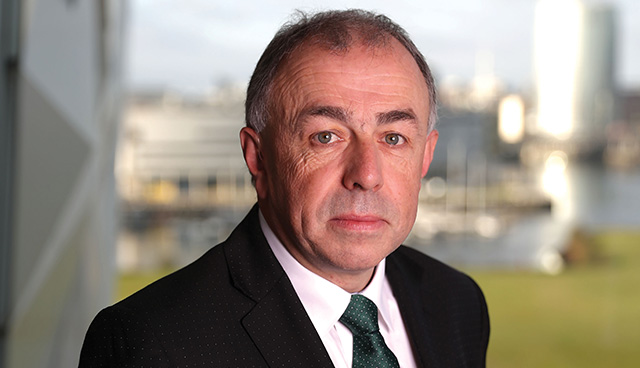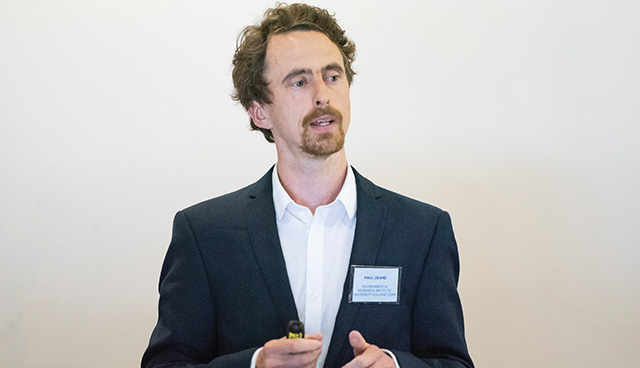
A future energy strategy for Northern Ireland
12th November 2018
What now for Northern Ireland’s largest energy proposals?
12th November 2018The role of renewable heat in unlocking Ireland’s low carbon future

Action on renewable heat is key to unlocking Ireland’s low carbon future, not only for its significant energy requirement but also because it can deliver a unique double dividend of achieving both renewable energy and emissions reduction targets, writes University College Cork’s Paul Deane.
Ireland has the second lowest level of renewable heat in Europe at just 7 per cent of all heat used. This is in stark contrast to countries like Estonia and Sweden who have already achieved levels of over 50 per cent. Ireland’s mandatory renewable energy target is to achieve 16 per cent of all energy consumed (this covers electricity, heat and transport) from renewable sources by 2020. Within this overall target, we have a 12 per cent sub-target of renewable energy from heat (this covers heat only) to come from renewable energy sources by 2020. Ireland is lagging behind on the headline target, primarily because of slow progress on renewable heat and it looks unlikely that our 2020 ambition will be met and instead compliance will have to be purchased to meet our obligations.
In addition to Ireland’s renewable energy, Ireland’s mandatory greenhouse gas emissions reduction targets cover heating, transport and agriculture (and exclude electricity generation). Renewable heat (and transport) provide a double dividend by contributing to both our mandatory emissions reduction targets (for installation outside of the EU-ETS) and our mandatory renewable energy target, unlike renewable electricity, which only contributes to our renewables target. Unfortunately, Ireland is also lagging behind on this target and again compliance will have to be purchased to meet our obligation.
Heat is the often-forgotten sector when it comes to energy and yet it accounts for about one-third of primary energy requirement. It is a sector dominated by oil and gas, with the residential sector the largest end user.
Today renewable heat is mainly provided by solid biomass but recent years have seen strong growth in the heat pump sector with about 30,000 domestic heat pumps installed in Ireland to date.
“A 2 per cent blending obligation of renewable gas from 2021 would give a similar contribution to converting 170,000 homes from oil to heat pumps in terms of emission reduction and compliment the policy to make heat cleaner.”
The Government-funded Support Scheme for Renewable Heat supports the installation of renewable heating systems for non-domestic heat users not covered by the ETS such as commercial, industrial, agricultural, district heating, public sectors. Grants of up to 30 per cent to support investment in renewable heating systems that use air source heat pumps, ground source heat pumps or water source heat pumps are available for successful applicants.
The scheme will also offer (subject to state aid approval) operational support in renewable heating systems for new installations or installations that currently use a fossil fuel heating system and convert to technologies like high-efficiency heat technologies. More details are available at seai.ie.
Beyond 2020, the journey to achieving Ireland’s 2030 targets also shows strong opportunity for renewable heat.
While Ireland’s overall renewable energy target for 2030 is yet to be decided, Ireland has pledged to reduce emissions in the areas outside of electricity generation by 30 per cent relative to 2005 levels. However, when comparing emissions forecasts and existing emission reduction policies in place a significant shortfall is observed.
The result is that Ireland has to find ways to reduce emission (over and above what is already planned in policy) by an extra 100 million tonnes in the period 2021 to 2030.
An important element of Ireland’s 2030 emission reduction responsibility is that compliance is measured across a range of years rather than a ‘snapshot’ of the final year. This means that early and sustained action is important as cumulative emissions reduction matter.
Encouraging cleaner transport through electric cars, more efficient homes and better heating systems such as heat pumps and renewable heat must play an important role in meeting these objectives and will require consumers to make ‘active decisions’ to purchase these items.
Research from SEAI shows that active decisions take time and effort. People have to learn a little about new technologies and then make a financial decision to buy. Consumers can be helped with access to good information and incentives like grants.
The Government’s ambition to convert 170,000 homes from oil heating to cleaner heat pumps by 2030 requires 170,000 individual household decisions and requires converting about 55 homes per day for the next 12 years from oil to heat pumps. Our ambition to have 500,000 electric vehicles on the road by 2030 requires families to make investment decisions. Because these measures take time, their cumulative contribution to emission reduction is smaller than one would expect if there was rapid and wide-scale adoption. Converting 170,000 homes and bringing 500,000 electric vehicles (EVs) on the road by 2030 makes a 5 per cent emissions reduction contribution to the cumulative gap to target in 2030.
A complementary measure is what is sometimes called an ‘invisible’ decision. These get less attention and are policies that people don’t really see or have to engage with much. A good example is Ireland’s biofuel blending scheme, which blends sustainable biofuels with petrol and diesel. The substitution of fossil fuel with biofuel resulted in an estimated reduction of circa. 450,000 tonnes of CO2-equivalent emission and delivers sustained emission reduction over a period of time.
A similar concept could be applied to homes using natural gas heating by blending the natural gas mix with renewable gas that meets sustainable criteria to provide renewable heat. The consumer would not see a difference or have to make a decision. A 2 per cent blending obligation of renewable gas from 2021 would give a similar contribution to converting 170,000 homes from oil to heat pumps in terms of emission reduction and compliment the policy to make heat cleaner.
It is important to note that these should not be viewed as competing measures. All are needed, and more is required. In fact, much more. In short, the journey to a cleaner future requires immediate action in the heat sector. While the 2030 targets may seem far off, the time to act is now.
Paul Deane is a research fellow at UCC’s Environmental Research Institute and a fellow at the Payne Institute, Colorado School of Mines. He is a scientific advisor to a number of international research projects on clean energy futures. His research focuses on scientific methods to understand future energy systems.
